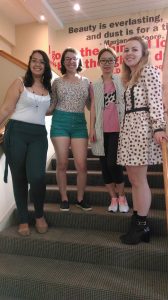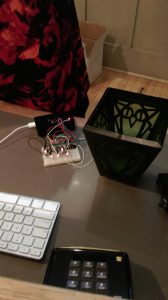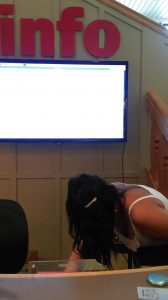Let Your Colors Shine is a special Bryn Mawr May Day project that lights up a lantern, symbolizing the light of knowledge, in Bryn Mawr class colors whenever someone tweets with their class hashtag (e.g. #bmc17 or #bmcMB). The project, temporarily installed at the Info Desk in the Campus Center, was created by the Digital Scholarship Research Assistants over the Spring 2017 semester, using a Raspberry Pi 3, some Python code, and a bread board full of LEDs and wires.

Who We Are:
Francesca Agnello: A rising senior and Anthro major learning to code on Code Academy who deeply regrets not taking a robotics class in high school when she had the chance.
Makenna Lenover: A rising junior and Anthro major learning how to troubleshoot while exploring her love of creation in a digital way.
Jiaxi/Jacy Li: A rising junior and Cities major experimenting with the fantastic microcontrollers while never getting the circuit diagrams right.
Nathália Santos: Brazilian, feminist, future Developmentist and lifelong learner. I’ve tried being a veterinarian, mathematician, and physicist, but I ended up becoming a Poli Sci and Econ double major. I’m an avid user of bullet-planning to make sure I don’t spend all of my time on Netflix.

(from left to right) Nathália Santos (’18), Francesca Agnello (’18), Jiaxi (Jacy) Li (’19), and Makenna Lenover (’19).
What We Do:
We are the first cohort of research assistants for Bryn Mawr’s new Digital Scholarship program. In an attempt to increase our digital competencies, we’ve all worked together on a special May Day project. After many weeks of wrestling with wires and fixing open source code we found online (many of us coding for the first time), our final products were complete: a green lantern filled with LED lights programmed to flash the class colors of Bryn Mawr (and of McBrides, too) and another lantern with an LED set that flashes the colors based on twitter hashtags (as well as a flash of white for #bmcbanter). It’s a great way to represent class pride while celebrating the last tradition of the year (and the last hurrah before finals).
Why We Do It:
We all came into the program with unique backgrounds as well as different strengths and weaknesses regarding our digital competencies. As a team, we decided to work together to incorporate digital scholarship into the Bryn Mawr community through a tradition we all love, May Day. This physical computing project included trial and error, multiple re-planning sessions, and hands-on learning. We gained valuable skills like grant writing, coding, and circuit configuration. When one of us had a problem, we passed it on to other group members, and through collaborative learning, we gained true problem solving abilities. Our team is passionate about Digital Scholarship, and we wanted to figure out a way to show the Bryn Mawr Community that digital scholarship is applicable in a multitude of contexts.
How We Do It:
Grant Writing: To fund our project, we applied for an internal Blended Learning grant, generously provided by the Andrew W. Mellon Foundation and administered by LITS’s Educational Technology Services. We used this opportunity to roughly plan our project and reflect on the materials we wanted to explore. Thanks to this grant, we were lucky to be able to order an abundance of physical computing kits, including Arduinos, Makey Makeys, and a Raspberry Pi.
Project Scoping: Once our materials arrived, we learned how to use them through various tutorials and experimentation. With these skills, we then had to develop a project that was reasonable to complete and readjusted several times as the semester progressed.



Experimentation: Each team member spent time working with the equipment and coding, trying to craft the perfect display for May Day. We experimented with MakeyMakey, Arduino Uno, Gemma, and Raspberry Pi. We tried to write a program that would light up the lantern with our class colors while also making an interactive piece for our classmates.




Finalization: Then came the time to put everything together. After countless project rescopings, analyzing circuit diagrams, and plugging and unplugging our devices, we finally got the lights to flash the colors we wanted. Thanks to Nathália’s tireless work, we now have the perfect code to not only time the flashes but make the LEDs respond to Twitter.



Presentation: We set up in the Campus Center for May Day, with the lanterns, our Raspberry Pi, a large screen to display the May Day tweets, and our hopes of success. After a bit of a rough start and quite a lot of troubleshooting, we successfully set everything up properly Sunday morning and watched in delight as our tweets appeared on the screen and the lantern changed colors. We periodically checked the lantern throughout May Day, and luckily there were no major issues. Everything worked as smoothly as we could have hoped, and we are all so proud of this successful project.

Want to learn more?
Check out http://digitalscholarship.blogs.brynmawr.edu/ for general info and LITS events you can get involved in! There’s even a summer internship to learn or enhance computing skills. There are plenty of opportunities for everyone, no matter the skill level!